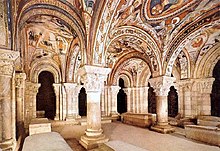Sancha of León
| Sancha of León | |
|---|---|
| House | Astur-Leonese dynasty |
| Father | Alfonso V of León |
| Mother | Elvira Menéndez |

Sancha of León (c. 1018
Life
Sancha was a daughter of
In 1029, a
At the Battle of Tamarón in 1037 Ferdinand killed Sancha's brother[5] Bermudo III of León,[6] making Sancha the heir and allowing Ferdinand to have himself crowned King of León. Sancha's own position as queen of León is unclear and contradictory. She succeeded to the throne of León as the heir of her brother and in her "own right"[7] but despite this, she is not clearly referred to as queen regnant, and after the death of her husband the throne passed to her son, despite the fact that she was still alive.[8]
Following Ferdinand's death in 1065 and the division of her husband's kingdom, she is said to have played the futile role of peacemaker among her sons.[citation needed]
She was a devout Catholic, who, with her husband, commissioned the
Children
Sancha had five children:
- Urraca of Zamora[11]
- Sancho II of León and Castile[12]
- Elvira of Toro[12]
- Alfonso VI of León and Castile[12]
- García II of Galicia[12]
Death and burial
She died in the city of

The following Latin inscription was carved in the tomb in which were deposited the remains of Queen Sancha:[15]
"H. R. SANCIA REGINA TOTIUS HISPANIAE, MAGNI REGIS FERDINANDI UXOR. FILIA REGIS ADEFONSI, QUI POPULAVIT LEGIONEM POS DESTRUCTIONEM ALMANZOR. OBIIT ERA MCVIIII. III N. M."
Which translates to:
"Here lies Sancha, Queen of All Spain, wife of the great king Ferdinand and daughter of king Alfonso, who populated León after the destruction of Almanzor. Died in the one thousand one hundred eighth era on the third nones of May [5 May 1071]."
References
- ^ Martínez Díez, Gonzalo. Sancho III el Mayor: Rey de Pamplona, Rex Ibericus. Madrid: Marcial Pons Historia, 2007.
- ^ a b Sánchez Candeira 1999, p. 48.
- ^ a b c d Viñayo González, Antonio. "Sancha Alfónsez". Diccionario biográfico España (in Spanish). Real Academia de la Historia.
- ^ Bernard F. Reilly, 26.
- ^ Justo Pérez de Urbel and Ricardo Del Arco y Garay, Historia de España, vol. 6, España cristiana, comienzo de la reconquista (711-I038), 2d ed.
- ^ Reilly, Bernard F. 1982. The Kingdom of León-Castilla under Queen Urraca, 1109–1126, 3. Princeton: Princeton University Press.
- ^ Janse, Sharon L. : The Monstrous Regiment of Women
- ^ Janse, Sharon L. : The Monstrous Regiment of Women
- ^ Gómez-Moreno, María Elena (1947). Mil Joyas del Arte Español. Barcelona: Instituto Gallach.
- ^ Sureda, Joan (1988). Historia Universal del Arte: Románico/Gótico. Barcelona: Editorial Planeta
- ^ Sánchez Candeira 1999, p. 226.
- ^ a b c d Sánchez Candeira 1999, p. 227.
- ISBN 9788492948451.
- hdl:10261/192759.
- ^ Álvarez da Silva, Noemi (2013). "La inscripción como imagen de poder en la Edad Media. El caso de Fernando I de León y su esposa doña Sancha" (PDF) (in Spanish). University of León. p. 12 – via Academia.edu.
Bibliography
- Blanco Lozano, Pilar. Colección diplomática de Fernando I (1037–1065). León: Centro de Estudios e Investigación «San Isidoro» (CSIC-CECEL) y Archivo Histórico Diocesano, 1987. ISBN 84-00-06653-7.
- Sánchez Candeira, Alfonso (1999) [1950]. Rosa Montero Tejada (ed.). Castilla y León en el siglo XI, estudio del reinado de Fernando I (in Spanish). Madrid: Real Academia de la Historia. ISBN 978-84-8951241-2.

